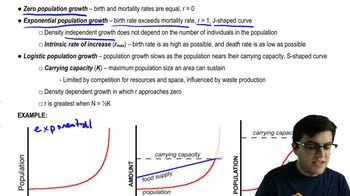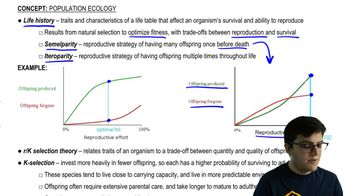Hi. In this lesson, we'll be talking about population ecology. A population is all the organisms of the same species that inhabit a certain area. Now, population ecologists are really going to be interested in looking at the abundance and distribution of population and how that changes over time. Some useful metrics they'll look at are population size, which is abbreviated with the capital letter n, which just represents or which is just looking at the number of individuals in a population, so it's just a simple tally. And they'll also look at population density, which is the number of individuals per area, or in some cases per volume, like for example, looking at organisms in the ocean. Now you can see here a nice graphic that shows us the population by country. Now, this can actually give us an idea of population density. For example, you might notice India here is quite dark, meaning that it's going to have a pretty high population. Now, Russia here is a lighter color. It's also a much bigger country, meaning that the population density in India is definitely going to be a lot higher than in Russia. Now, of course, population ecologists are going to want slightly more specific information than the density in the whole country of Russia, but you get the idea.
They're also going to want to look at range. This is the geographic distribution of a species, and it's going to be due to biotic and abiotic factors. Some of the biotic factors will be like the other organisms present in an area, and whether they can act as food perhaps, or whether they'll compete with another species. Now some of the abiotic factors are things like climate and physical barriers, like mountain ranges or bodies of water like the ocean. Now, population dynamics look at the size and age composition of populations, and they're interested in the processes that drive them. So one of the things they're going to be interested in is immigration and emigration. Immigration is the influx of new individuals from another population. So individuals from some other population will enter our population, as you can see here. And emigration is the movement of individuals away from a population, so that's going to be reducing our population size. Now, immigration and emigration combined with births and deaths will basically give you a good idea of the size and stability of a population.
Now, populations that are separated by space but interact in some way are called metapopulations. So, basically, if you have, let's say, 2 populations that live on either side of a lake, population 1 over here and population 2 over here, and occasionally they swim out into the middle and do a synchronized swimming routine or something just to entertain the local folks, well then you have a metapopulation because these two populations are separate, separated by space, but they do interact in some capacity when they do their synchronized dance or swim, or whatever it is. Now immigration and emigration can actually link populations into a metapopulation. So if you have those 2 populations, again separated by space, and maybe they don't really see each other, they don't do those synchronized swims anymore, but occasionally some people from population 1 move over to population 2 or vice versa, then you still have a metapopulation.
Now the thing is populations in metapopulations will regularly go extinct, but individuals can colonize new territories. So in a metapopulation, you might have let's say 3 populations even if let's say population 2 goes extinct, you might have some individuals start a new population and return to a state where you have 3 populations in your metapopulation still. Or, for example, if you think about it on a much greater scale, if you have a 100 populations in your metapopulation, even if one of those goes extinct, the metapopulation is still going to survive.
Alright. With that, let's go ahead and flip the page.


































































